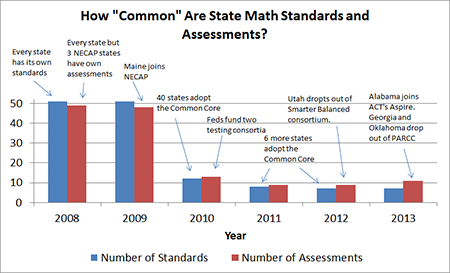For all the news and speculation you hear about which state is in the Common Core and which state is out, so far it’s mostly just smoke. Education Week has a nifty state legislation tracker on Common Core, and what it shows is a lot of failed attempts.
When Georgia announced its decision to drop out of one of two federally funded assessment consortia aligned with the Common Core, it sparked a lot of Twitter hand-wringing about Common Core implementation from Andrew Smarick and Rick Hess, not to mention a Politico article using verbs like “crumbling” and “unraveling.” But keep in mind this is still just Georgia we’re talking about here, and they didn’t even drop out of the Common Core. In fact, the map of which states have adopted the Common Core State Standards looks the same as it did a year ago. See for yourself here.
Let’s take a step back to take stock of where we are today and how things have changed in the recent past. The 1994 and 2002 versions of the Elementary and Secondary Education Act required states to adopt standards in math and English language arts and to create assessments aligned to those standards. Each state and the District of Columbia adopted their own standards, and except for one minor exception, every state had its own assessment system aligned to its own standards. (Three states—New Hampshire, Rhode Island, and Vermont—joined together to create a common assessment called the NECAP, the New England Common Assessment Program). Starting in 2008, here’s what’s happened chronologically:
• 2009: Maine joins NECAP.
• 2010: 38 states and D.C. adopt the Common Core. The U.S. Department of Education funds two consortia creating assessments aligned to the Common Core.
• 2011: Five more states join the Common Core.
• 2012: One more state, Wyoming, joins the Common Core, bringing the total to 45 states plus D.C.
• 2013: Georgia drops out of the PARCC testing consortia to design their own test. Alabama elects to use ACT’s assessments that will also be aligned to the Common Core, called ACT Aspire.*
To see this visually, see the simple graph below.* Importantly, it separates out standards from assessments. For simplicity’s sake, it focuses only on math standards (Minnesota plans to use the Common Core in English language arts but not in math). It is also forward-looking, since the Common Core does not actually start in most states until the 2013-14 or 2014-15 school years. The blue bar tracks the number of unique K-12 education standards in use across the United States. The red bar tracks the number of unique assessment systems states use.

What this graph helps illustrate is that we have a lot more commonality in standards and assessments than we did five years ago. We never got to perfect commonality, and, in fact, the trend is slowly moving in the other direction. If other states follow Georgia’s lead and go their own way on assessments, that red bar will continue to creep up. But, if states switch between consortia, join ACT’s Aspire, or work with another state, the number of assessments will stay the same. No state has officially dropped out of the Common Core standards yet, but that blue bar could rise over time as well.
The other thing this graph shows is that, the Common Core is far from “crumbling” and it’s barely even “unraveling.” The next time you hear about a state considering a new assessment, keep this graph in mind. Take a deep breath, and remember how far we’ve come in a relatively short period of time.
-Chad Aldeman
*Disclosure: ACT is a client of Bellwether Education Partners, where I work.
Correction: Our original post failed to acknowledge that Utah also left one of the two assessment consortia, leaving Smarter Balanced, but not the Common Core, in August of 2012. The graph has since been updated accordingly.
This blog entry first appeared on the Quick and the Ed.


